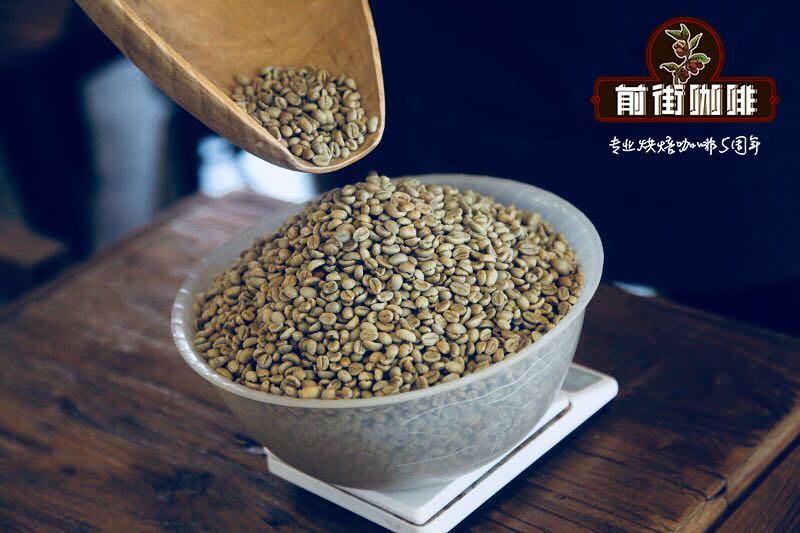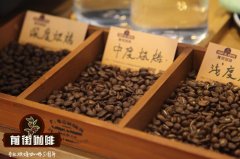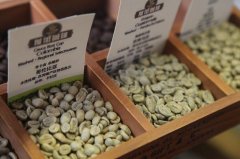What is the grading of coffee beans? how is the coffee grade pyramid divided?

Professional coffee knowledge exchange more coffee bean information please follow the coffee workshop (Wechat official account cafe_style)
The latest knowledge arrangement of raw coffee beans: the classification and naming rules of coffee beans
What is the grading of coffee beans?
Usually when we look at individual coffee, we often see one or two acronyms in the long name, such as PB, AA, G1, etc., which actually represent the grade given to coffee beans by the producing country.
There is no universal coffee bean grading system on this earth.
The purpose of grading is to provide a rough benchmark at the time of trading. It must be noted that there is no universal coffee bean grading system (draw the bottom line) on this earth. In fact, the name and basis of the classification is decided by each producing country. There are a few points that we must pay special attention to when discussing the classification system:
The standard of grading varies from country to country.
In some countries, the name of the grading system is the same, but the actual definition is not quite the same.
It is difficult to make cross-border comparisons because the systems are different and the characteristics of each country are different.
Grading is only a reference and is not the only or most critical factor affecting flavor.
What is the basis for grading?
The common criteria for grading coffee beans include the size of the bean itself, the shape, color or hardness of the bean, the ratio of defects, altitude, area of production, variety, treatment, feeling and quality of drinking, and so on.
Please don't be bound by these grading systems, but forget that the most important thing is to drink good coffee.
One of them has been in practice for many years, and the criterion adopted in most producing areas is the size of the bean itself. Yes, it is based on the size of the particles as the basis for grading. If you grow bigger, you will win. The idea behind this is that the higher the altitude, the better the coffee grows. If the temperature is lower, the fruit will take more time to mature, and the bigger the beans will be, the harder the texture will be and the better the flavor will be. If you eat more, of course you will be fatter.
The particle size of beans may indeed have something to do with its flavor performance. But as written in the biology textbook of junior high school, there is no absolute thing in nature. The grading system is just one of the many links in coffee. Therefore, please do not be bound by these grading systems, but forget that the most important thing is to drink good coffee.
Distinguishing between different bean sizes in advance actually has a great advantage (important). That's convenient for baking beans. If the size difference is too big, it is easy to be heated unevenly when baking, so that there is no way to present the good cup to you and me.
Filtered specifications
The screening work (Screening) is usually carried out with metal screens with different hole sizes. The basic unit is 1x64 inch, which is called "eye". The screen used to screen coffee beans is in the range of 8muri 20 mesh, that is, 8ram 64MB 20x64 inch. The smaller the number, the larger the hole. Usually less than 14 goals, there is no chance of becoming a boutique. In the process of screening, of course, there will be fish out of the net, and the allowable value of error depends on the standard adopted.
The following is to explain several important country-to-country classification systems. Because it is too complicated, please make sure that when you see the graded name, you should also pay attention to where the country of production is, so as to avoid Zhang Guan and Li Dai.
Kenya
Grade description
E
E refers to the elephant, but not the elephant bean species in the breed. Generally speaking, there are two seeds in a fruit, affixed face to face, so there will be a flat side, called flat beans, mother beans or double beans. E is a bean in which two seeds stick together in the process of growing up and become oversized. A small amount is a naturally occurring variation.
AA
The hole of the screen is about 7.20 mm, and the price of this grade is better.
AB
The filter size of An is 6.80mm and that of B is 6.20mm. These two are sold together, so they are called AB. In a harvest, most of the coffee beans will be concentrated in this grade.
PB
It is called Peaberry in English and small round beans in Taiwan, or public beans or single peas, relative to ordinary flat beans. It is rare to get small and round beans because there is only one seed in the fruit. The effect on flavor is inconclusive, and some people like it so much that PB will be singled out for sale.
C
The size of the hole is 4.8 mi 5.6 mm, which can be regarded as a small grain of beans.
TT
It is usually defective beans that fall to this level. Cry.
T
At this level, there are usually only crumbs, defective beans, and small beans less than 4.8 mm.
MH/ML
Beans of very poor quality, such as overcooked beans dropped on the ground, will not be sold for export.
Note: commonly seen AA+, AA++, AA Top, AB+, is the trader's own rating, not in the official system of Kenya. Different trade associations have different definitions, so let's make reference.
Ethiopia
In the Ethiopian grading system, a classification system that starts with G and is divided into 5 to 1 grades is the most common (Z is a new series that has just emerged in recent years). The smaller the number, the better, mainly looking at the defect rate, based on "every 300 grams of raw beans." the number of defective beans allowed is listed as follows:
Number of grade defects
Z 0dZero Defect, can be met but not sought.
G1
< 3,炉锅咖啡的埃塞俄比亚豆都在这个等级 G2 4–12 G3 13–25 G4 26–45 G5 46–90 UG 排不进分级 埃塞俄比亚约在1970年代引进水洗处理,当时,水洗被视为较高级的方法,因为比较容易得到整齐的品质。因此,早年只有水洗排得进G1–G3,日晒则在G4–G5。不过,近年来,市场上涌现的日晒复兴浪潮,让排得进前三等级的日晒豆,也开始出现,并成为常态。 想要了解处理法是什么,请参阅什么是处理法,有简单的介绍。 哥伦比亚 哥伦比亚以豆粒大小做为区分的标准,Excelso, Supremo都算是大颗的豆子,但后者比前者更大一点。哥伦比亚通常被拿来举例:相较于豆粒大小,如果可以知道产区来源的话,对了解品质会比较有帮助。 等级 说明 Supremo 17目 Excelso 14–16.5目 巴西 由高到低,分别是Stictly Soft, Soft, Softish, Hard, Riada, Rio, Rio Zona,Hard开始,包含更低的等级,算是商业豆。 巴西是世界上咖啡产量数一数二的国家,从廉价的即溶咖啡,到精品等级的庄园豆都有。受制于自然环境,巴西的咖啡生长高度较邻国来得低,大约只有海拔600–1200米,因此发展出自己的等级排序。名称里的Soft,不是指豆子软硬,而是指风味有温和、柔顺的表现。 大部分中南美洲国家 大多数的中南美洲国家,都以生长的海拔作为基准,SHG >HG,SHG and SHB have the same meaning, and so on. In fact, the height of growth is different from country to country. For example, in Ecuador, the SHG is more than 1300 m and the HG is 1220 mi 1300 m; in Honduras, the SHG is over 1200 m and the HG 1000 mi 1200 m.
Grade description
SHG/SHB
Strictly High Grown / Strictly Hard Bean, extremely hard beans
HG/HB
Hight Grown / Hard Bean, hard beans
Other
Beans at lower elevations have different names from country to country.
Good taste is the most important thing.
Because it is too important, so to say again: coffee tastes good is the most important, grading system is not the only factor affecting the flavor, its advantage is that it can make beans more evenly heated when roasting. In addition to classifying our online stores by baking degree, we can also search from the producing area. In addition, you can press "Select Flavor" on the right side of the screen to further screen according to your preferences:
Central and South America
Clean and clear, rich and varied, sweet and sour fruits, caramel, honey or chocolate
Africa
Distinctive personality, easy to identify, bright flower and fruit fragrance, dancing, instant blooming joy
Taiwan
The serious cultivation of small farmers in Alishan makes people think of the happy taste of hometown.
Special tone
Mellow taste, balanced flavor and long-lasting finish, suitable for all kinds of cooking methods
World Top Coffee beans-Kenya aa Coffee beans Kenyan Coffee has 7 grades
Important Notice :
前街咖啡 FrontStreet Coffee has moved to new addredd:
FrontStreet Coffee Address: 315,Donghua East Road,GuangZhou
Tel:020 38364473
- Prev

How to distinguish the grade of coffee raw beans what is the basis of coffee grade classification?
Professional coffee knowledge exchange more coffee bean information please follow the coffee workshop (Wechat official account cafe_style) the latest coffee raw bean knowledge collation: coffee bean classification and naming law coffee raw bean is what to distinguish the grade when the coffee bean is harvested, after layers of treatment, the appropriate drying, keep the sheepskin storage for about 24 months, obtained in the current season
- Next

Grading system of major coffee producing countries in the world popular science coffee grade shb and coffee bean grade G1
Professional coffee knowledge exchange more coffee bean information please follow the coffee workshop (Wechat official account cafe_style) the latest coffee raw bean knowledge collation: coffee bean grading and naming rules want to drink a certain quality of selected coffee beans, starting from understanding the grading system of coffee-producing countries is a necessary lesson for each producing area, each piece of soil, different climate, different treatment methods
Related
- Beginners will see the "Coffee pull flower" guide!
- What is the difference between ice blog purified milk and ordinary milk coffee?
- Why is the Philippines the largest producer of crops in Liberia?
- For coffee extraction, should the fine powder be retained?
- How does extracted espresso fill pressed powder? How much strength does it take to press the powder?
- How to make jasmine cold extract coffee? Is the jasmine + latte good?
- Will this little toy really make the coffee taste better? How does Lily Drip affect coffee extraction?
- Will the action of slapping the filter cup also affect coffee extraction?
- What's the difference between powder-to-water ratio and powder-to-liquid ratio?
- What is the Ethiopian local species? What does it have to do with Heirloom native species?

